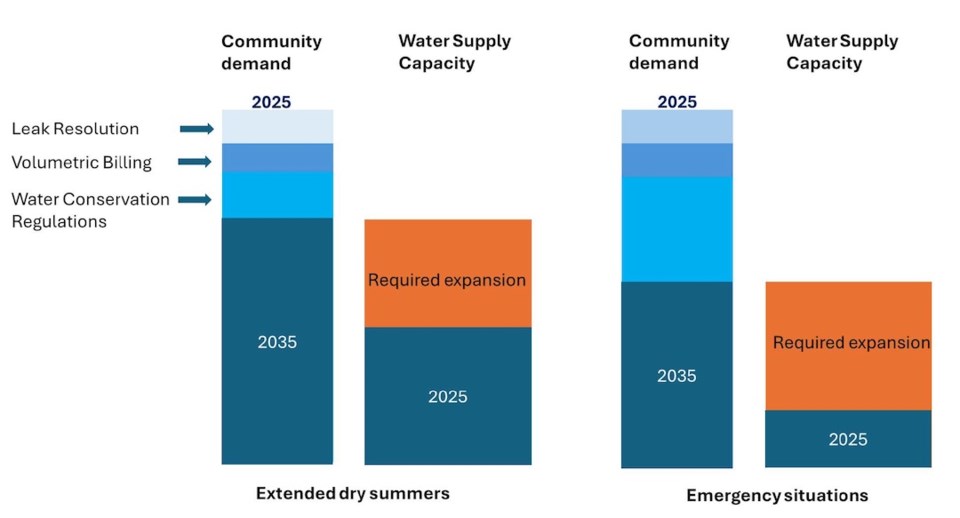Just over two full bathtubs of water a day.
It’s no magic number, but 750 litres per residential connection per day during an extended dry summer (May 1 to Nov. 31) is the water supply objective Sunshine Coast Regional District (SCRD) directors supported during their July 17 committee of the whole. The goal would be to achieve this in Stage 1 and 2 water restrictions.
In an emergency where one or more water supplies are out of commission (due to earthquake, pollution, equipment failure or other issues), the SCRD would aim for 350 litres per residential connection per day.
The objectives to be incorporated into the 2025-2035 Water Strategy as a guidepost as the SCRD expands and entrenches water resiliency.
“It's important for us to have a target for us to be working towards, because right now we don't,” said chief administrative officer Tina Perreault. “If we have some clarity, even if it's not perfect, [it] would help communications, messaging, policy documents.”
The message to the public remains conservation, said Perreault and general manager of infrastructure services Remko Rosenboom at the meeting. Rather than being an allotment households are allowed to consume (that’s not the intent), 750 litres per connection per day target allows the SCRD to start somewhere in infrastructure planning.
How did staff reach the numbers?
Average daily demand in July and August 2022 was 1,200 litres per connection per day. The same months the year before, that number was was 1,350.
The 750 litres per connection objective could be met through increasing water supply capacity and more efficient use of water, said Rosenboom. He anticipates the implementation of volumetric building and resolving more leaks could result in demand decreasing 20 to 30 per cent compared to 2023.
Staff don’t recommend setting a supply objective based on only Stage 1 restrictions being in place, as the financial, technical and operational implications of maintaining that during a prolonged dry summer are “very substantial,” said an accompanying staff report. The biggest drop in water use happens between Stages 1 and 2, said Rosenboom, as that’s when lawn watering is eliminated.
An objective below 750 litres per connection per month can only be achieved by implementing Stage 4 for most of the summer, said the report.
Staff reached the 350 number for emergencies based winter water demand. Average monthly residential demand was usually just above 400 litres per connection in the winter months of 2019 through 2023.
Only residential demand is included in this objective (not commercial and institutional) as it’s the “biggest driver for total use,” said Rosenboom. Keats Island’s Eastbourne system is outside the scope of this report as it has much more limited water supply.
Siphons critical
The report includes high-level modelling for the implementation of eight projects in the wings (siphons, environmental flow needs optimization of Chapman Creek, leak resolution, volumetric billing, Langdale well field, Lower Crown reservoir and the two hospital well field phases), three scenarios could be fully implemented by 2028 at the earliest, said the report. The modelling assumes two per cent annual growth.
The siphon systems at Edwards and Chapman lakes “are critical to maintain Chapman Creek EFN-requirements during an extended dry summer,” said the report. If continued use of the siphons is approved, then it may be that only one additional large water project (eg. Langdale or Hospital Well Fields, Lower Crown Reservoir) would provide sufficient capacity during extended dry summers, though more assessment is needed to see if this would meet peak demand (like when there’s a big fire).
A large additional source could provide operational and financial benefits, said Rosenboom.
If the siphons are not approved to continue, two additional large water sources would be needed and further analysis would be required to confirm whether a third additional supply would be needed to meet peak demand, said the report.
The report notes that the Lower Crown reservoir’s function as an emergency water supply only works if the Chapman Creek Water Treatment Plant is operational.
Directors noted that 750 litres is a lot of water.
“Our averages in the SCRD are severely skewed by the high-end users,” said Elphinstone director Donna McMahon. Thirty per cent of the water is used by less than five per cent of the connections, pointed out McMahon, so the majority of residents use well under the 750 threshold.
“I'm not sure if we're going to be able to find a perfect goal,” Perreault noted. “I think there are some continuous conversations that need to be had."
The communications strategy needs to be “reduce, reduce, reduce,” said Rosenboom, but the 750 provides a target for the SCRD to build towards.
The objectives still need board approval and are recommended to be reviewed in 2030.



